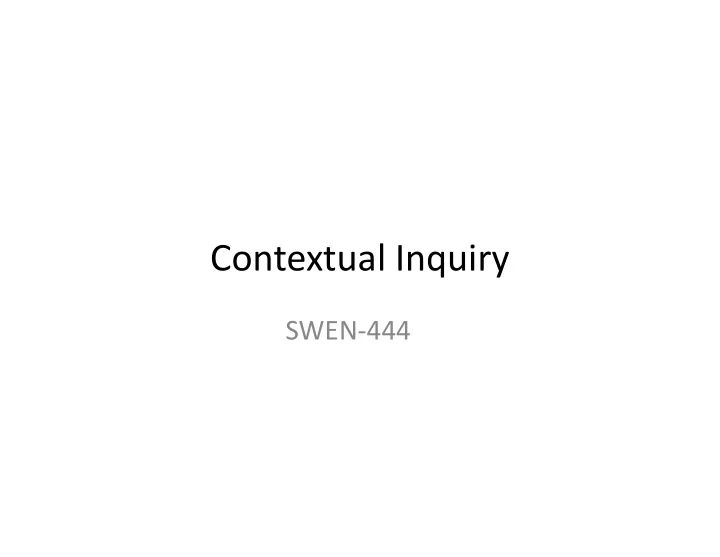

Contextual Inquiry SWEN-444
Contextual Inquiry is the process of discovering what users cannot tell you. Interview + Observation
The Flashlight, an Example of How Understanding Work Practice Paid off
CI Preparation • Do your homework – learn about the application domain and the business – Research – e.g., internal environment, market, technology, terminology, competition, current products/systems • Connect with the lead customer (decision maker) – Build a relationship – Validate the mission statement – Plan logistics for interviews and observation – who, when, where – Especially identify the target user roles and work activities
Tips for Interviews and Observation • Have a going-in-plan – what questions do you want answered? – Utilize the 5W+H heuristic – who, what, why, when, where + how – Adapt according to what you learn – Goals - what users do , how they deal with problems but also how do they “ feel ”, what are their personal goals ? – Identify work related information – Collect any helpful work related artifacts
Tips for Interviews and Observation • Sessions … – Make the user feel at ease, explain the process – Don’t lead the witness, have them tell “stories” – 1-2 hours max – Take notes (record)!!! Have an organizational scheme (“bins”) – e.g., user roles, work activity, work environment, social relationships, emotional expression, design ideas, … • Pitfalls … – Hearing not listening – Side tracks – Your personal bias – Is the user speaking the truth?
“Principle: People are experts at what they do - but are unable to articulate their own work practice.”
At a prior university the library decided to figure out why researchers were not backing up data. They tried surveying, but people left out important information. So they sent someone around to various research labs to do a contextual inquiry.
Example exchange with researcher • Researcher: we back up our data onto local servers which are then backed up to an online service. • Interviewer: What about that? (pointing to the tablet in my hand) • Researcher: I have a folder on this which rsyncs (uploads) to my backed up computer once an hour when I am at work • Interviewer: What about when you travel? • Researcher: It doesn’t backup, but I consider the risk minimal
The Result • Researchers were not considering mobile devices like phones and tablets or cameras when describing where their data was • They were using Dropbox instead of university services to sync to things like mobile devices • Sources like Google Docs were also not being reported • Large files like detailed photos or video were all being stored locally • Some data was being printed and stored in hard copy with no backup
Think-pair-share • Find one person from the people near you who is willing to share the contents of their backpack • Have them go through the different objects and explain why they are there • Ask questions to understand why the person needs each of these objects
Project- Interviews - Devise an interview plan. What questions do you want to ask users about the system problem? Introduce your system concept as a starting point. - How will you record/take notes during the interview? raw data notes on paper or a laptop. - Practice by interviewing a student from another group, and then let him/her interview you - Document the interview plan in the Design Requirements template - Identify and contact 4 users
Recommend
More recommend